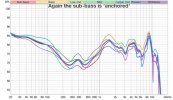Introduction
I have a bit of a love / hate relationship with Soundcore devices. I love the value and feature set they typically offer. Often their devices can be found on sale at almost 'disposable' discounted prices, but they are a long way from 'audiophile' territory, with cheap 'plastic' build and with a typical default sound signature of boomy bass and typically very uneven treble. But since getting a Soundcore Q30 headphone a few years ago, I was very impressed with their built-in EQ features which allowed a reasonable sound signature to be saved permanently to the device, that with the decent (for the price) ANC and other typical bluetooth headphone 'lifestyle' features meant it was always a good headphone to throw into a bag and bring on trips and when working in a noisy environment.Having previously, customised the EQ by ’ear’ listening to some test tones I was curious, just how much improvement can I make the Q30 using subtle changes to the 10 band EQ within the Soundcore App. I had recently decided to buy a IEC711 ‘clone’ coupler and a clone KB501X ‘soft’ ear pinna from aliexpress for a bit of measurement ‘fun’ and I had been measuring all my headphones and IEM’s. So after a little tweaking of the calibration I was happy that my setup was as good as I could hope ( especially for a couple of hundred dollars that the coupler and the pinna cost ).
Since the Soundcore devices I had bought previously have never been measured ( except by some Youtubers who never published a proper result ). I thought why not put together this post with some thorough measurements. This post isn’t really a review of any these devices (other than a few subjective comments) just a presentation of the measurements I got and the recommendations I got from tweaking with the 10 band EQ available to get them close to the Harman target.
Here are the 3 soundcore devices I used in this post, the Q30, the Space One and the P3i TWS:
Anyway, lets get onto the devices and the measurements:
Q30
This was my initial Soundcore headphone, it was (and still is) a very cheap fully featured ANC bluetooth headphone (currently around $60 probably even cheap when on sale), though by the latest standards it is a bit outdated and missing some features and codecs that have become standard even at this low price point. I used the AAC codec for these measurements (with a Macbook Pro running REW).As I mentioned for me the key feature, beyond the Active Noice Cancellation, is the EQ built into the ‘companion’ Soundcore Application. There are lots of the usual ‘preset’ categories within the EQ feature of the App but crucially there is a ‘custom’ section. This is the custom section I will be mainly measuring with all 3 headphones presented in this post as once you have tweaked your EQ in that section it is saved into the headphone no matter how many future devices you use with the headphone, as someone who often has to swap between IOS and Android and between a Macbook and a PC laptop for work, having headphone with ANC in a noisy office environment with ‘good’ tonality is ideal.
Frequency Response
*Note: The Q30 was pretty difficult to get a consistent seating, it took a few attempts to get it “correct” otherwise I was getting a screwed measurement of too much or too little sub-bass or exaggregate treble, but once I got a good seating I tried to replicate accross all measurements.Note: All measurements were also taken with the ANC enanbled. I did notice that Transparency has a huge discrepency on the Frequency Response but I don’t anyone would care about the Frequency response with Transparency enabled *
Firstly, just to show how boosted the basss is with the ‘default’ soundcore profile and even their ‘flat’ sound profile is way too bass heavy. Here for the Q30 compared to what I ended up with after playing around with the EQ to get closer to the Harman OE target, though the sub-bass cannot be tweaked so the sub 100hz was always higher than I would have liked:
I did measure the various presets - the ‘podcast’ preset was the nearest to my eventual EQ. Might be a quick option especially if you are going to use ’external’ EQ to further ‘fix’ the Q30 sound profile, i.e. just select ‘podcast’ then EQ within your own App:
The left and right channels show lots of channel in-balance especially in the treble - this was with my EQ applied:
I also measured a second Q30 (as my wife wanted one) for comparison and channels were somewhat consistent (this was with the ‘flat’ soundcore profile - which is the same as their default as my wife’s Q30 was just using the defaults):
Now, to determine was possible with EQ, I measured all the extremes of all the EQ filters so here are the various measurements the min and max levels ( +/- 6 db according their app) on all 10 bands, the sub-bass does not change with the 100hz filter so ’taming’ the bass is difficult:
Here is the normalised view of range of dB possible with each of the max and min levels for the Q30. This is shows that you do get about the +/- 6dB range promised within the App, though a few places it is only about +/- 4dB. You can also see the Harman target in the background and why the lower bass is always a problem:
Overall this is, as you will see later in this post, far better for tweaking the sound than newer Soundcore ‘Space One’:
Note: As well as attaching the REW measurements, I have uploaded all measurements to my headphone database for anyone to look at and generate their own EQ.
Here is what my recommended ‘custom’ harman EQ profile looks like within the Soundcore App, though as I said early the ‘podcast’ preset would make a good quick EQ to then use as a basis for further EQ:
This ends up with this reasonable Frequency Response:
And finally here is the distortion:
Space One
The Space One is the latest generation of the ’entry level’ of Soundcore headphones, currently around $99 with regular sales bring it down to $79. The Space One has lots of upgraded features over the Q30 including some additional audio features to personalise the sound, e.g. ‘HearID’ but they also retain the same 10-band ‘custom’ EQ, so again I was curious to how well I could tweak the sound using EQ.Again lets start with some of the default ‘presets’ offered in the Soundcore app:
This looked promising as the ‘default’ sound signature is not as bass heavy as the Q30 but as you will see things were not quick as easy to manipulate with the Space One.
And here is Soundcore default compared with what I ultimately tweaked it after doing the measurements:
Simmilar to the Q30 I took lots of measurements of the different EQ min/max levels.
Here are the various min/max levels offered by the 10 band EQ:
Normalising these measurements we see that the range between the min and max values are not the same as the Q30:
Zooming into one of the EQ filters (the 100 hz) one we see it clearer:
And then inspecting the values we see we only get +/- 3.1db instead of the +/- 6db we did with the Q30:
As you can see, sadly with the Space One you do not get the flexibility you can get with the Q30. This is the main problem I have with the Space One, you cannot get it to a ’natural’ sound with the built-in EQ and the best I could do was to flatten the V-shaped sound, the treble is very variable with large peaks so harder to flatten with an external EQ.
Here is the EQ I settled on within the Soundcore App due to the limited range it is ‘pretty drastic’ EQ:
This EQ tames the Frequency response somewhat - but its a pity the EQ doesn’t have more ‘range’ as the bass, midrange and especially the treble still need extra EQ:
And finally here is the distortion on the space one:
Note: I did find general feature set including the ANC was much better on the Space One compared to the Q30 - I guess the technology behind ANC is improving every year and the adaptive ANC on the Space One is excellent, just a pity they limited the EQ.
P3i (True Wireless Set)
Up until the summer last year I was mainly using the Airpods Pro for my “TWS use case” of listening to podcasts, audiobooks and to utilise the microphone for conference calls. I thought they were pretty good (though the sound profile wasn’t great) and I could never get a satisfactory ‘seal’ with the bundled ear tips (or even third party ones). So when I accidentally left them in th washing machine and found I messed up the microphone, I decided to look for a simpler / cheaper TWS set, in case I made the same mistake again.The market is full of cheap TWS sets but after some experimentation, I settled on the Soundcore P3i model of TWS. Initially, because it was cheap (typically < $50 and sometimes cheaper) the microphone quality was good and it had a larger internal cavity (so I could use some XL sized eartips to get a good seal) and again given my experience with the Q30 the fact that it has the 10 band EQ within the Soundcore app was a bonus, though I originally had not planned to listen to much music with the P3i (I have lots of IEM’s and other headphones), but I actually found having it ‘in my pocket’ all the time was a great bonus.
With the extra large eartips:
Note: While I like it for the ability to use much larger eartips I measured it with stock ‘medium’ eartips.
Again lets start with some of the default ‘presets’ offered in the Soundcore app:
And here is Soundcore default compared with what I ultimately tweaked it after doing the measurements:
Again here are the various min/max levels offered by the 10 band EQ:
And those values normalised:
Inspecting the values we see - we get +/- 6db range for each filter again with the p3i:
And here is the soundcore App EQ settings I settled on:
This resulted in this Frequency Response:
Finally, here is the distortion:
Conclusion
I love trying to use EQ to fix the tonality of headphones, IEM and TWS especially when those settings are saved with the device rather than saved in an App on your phone or computer. I have a few other EQ enable devices and even some PEQ cables like the ‘Moondrop FreeDSP’ which I will do a similar exercise on soon. But with these Soundcore headphones you can get a respectable (though not ideal) tonality using EQ. With the P3i TWS I personally got a very satisfactory TWS device with extra large eartips and good tonality.So for audio quality the Q30 is still a bargain ANC headphone and much easier to tweak the EQ within the Soundcore App than with the Space One. Its ANC is good ’enough’ for the price (though the Space One has better ANC) it can offer a very pragmatic headphone especially when on Sale. The Space One on the other hand is more a consumer orientated headphone (with lots of features) with V-Shaped sound signature but lacking the same ability to ‘fix’ the tonality.
Finally, I think with the P3i, Soundcore have an excellent TWS set for the price with a good microphone, excellent sound quality (after applying custom EQ profile) and the ability to use custom ’extra large’ eartips and still close the case.
Attachments
Last edited:


